
British Army: 2300AD
By D Hebditch and Bryn Monnery
|
Above: Photograph printed on the frontpage of 'The Free New African' newsheet with the headline 'About Bloody Time!', 28 July 2302 at the start of the 3rd Liberation of Beta Canum-4. A long-lens shot taken with a low-quality night vision camera by an American freelance photojournalist, it shows a Montgomery of the 2nd Dragoons by an arch of the badly damaged Meakon Viaduct close to Landing Zone Golf. |
| Vickers FV825 'Montgomery' Hover Battle
Tank The Montgomery is one of a long line of hovertanks produced by Vickers. In terms of chassis and powerplant it is a progressive development of their excellent Cavalier HBT that set the standards for gun armed HBT's for the last 25 years and still performs respectably alongside modern types such as the AC-12 and LkPz-IX. However the Montgomery represents a change in design philosophy brought about by the lessons learned from the Central Asian War. Namely that any gun combat between hovertanks results in serious attrition losses for both sides, and that the French achieved some of their best results against Manchu armour using lighter, missile-armed tank destroyers. The MOD decided to combine the two types. The new HBT was to combine the tried and tested gun and fire control system of the Cavalier. Whilst also mounting a substantial missile armament enabling the HBT to stand off and co-ordinate long range strikes through reconnaissance assets. The primary drawback of this system was the increased cost of the system, roughly twice that of the Cavalier. Production started in 2295 at Vickers' Leeds factory, and the first delivery went to 7 Armoured Brigade and slowly spread through the Armoured Divisions. A secondary program was also underway upgrading the Cavalier HBT with add-on missile packs and armour for units not slated to receive the Montgomery. The weapons configuration on the Montgomery are relatively conventional with most of the armament being mounted in a centrally mounted remote turret. One problem was that the crowded antenna configuration on the turret roof restricts the traverse of the point defence system in the left hand arcs. The Montgomery's software was rewritten to allow the point defence system to override the main turret and rapidly slew it to unmask a target. The Sky Streak missile system is located in the rear of the vehicle with two vertical launchers and magazines mounted either side of the engine. The Montgomery had several teething problems on introduction, especially with the integration of the missile suite into the Black Arrow FVIS-7 computer system and inter-vehicle datalinks. In terms of reliability the Montgomery exceeded its predecessor once the maintenance teams were properly trained to handle the revised automated diagnostics. The sensor integration of the AGATS (Automatic Gunnery And Tracking System) took some refining in trials on Wellon, but has now greatly reduced crew workloads in target acquisition and selection. The primary internal change from the Cavalier to the Montgomery came in the mounting of the armoured crew compartment so that the crew sit in tandem rather than side to side. This was mainly undertaken to accommodate the missile magazines within the chassis but also because of a change in roles. Rather that the traditional driver and gunner/commander roles the two crew have identical workstations and controls so that work can be shared between them in a manner most conducive to that particular team. Most crews have retained the traditional divisions of responsibility from the Cavalier, but some are increasingly using the Montgomery in a more innovative manner. The Kafer War saw an abrupt change in procurement practise and a leap in Montgomery production. Expeditionary units were the first priority, and Montgomerys were also shipped to Tirane to equip Wellon Army units. A license was also awarded to the Consolidated Alicia Corporation to produce the Montgomery at Beowulf. The Alicia Defence Force quickly re-equipped with this impressive weapons system and CAC produced Montgomerys would help replenish battle damaged Commonwealth units throughout the French Arm. The Montgomery's combat debut occurred on BCV-4 as the Kafers invaded that world. In the hands of the 6th Dragoon Guards (Carabiniers) and 10th/11th Hussars, the Montgomery proved itself exceptionally formidable. Using the missile armament to pick off Kafer armour they would then sweep in and finish off the remaining APCs with guns before breaking contact. These tactics were hugely frustrating for the Kafers, and played a large part in keeping most of New Africa from Kafer domination. The US Marines who fought alongside the British in the later stages of that campaign were hugely impressed with the Montgomery's performance advantage over their older M-9's. All Medium Tank and Recce regiments of II (Commonwealth) Corps (Alician, British, Canadian, Wellonese and New African) on BCV-4 and Crater are now equipped with the Montgomery.
|
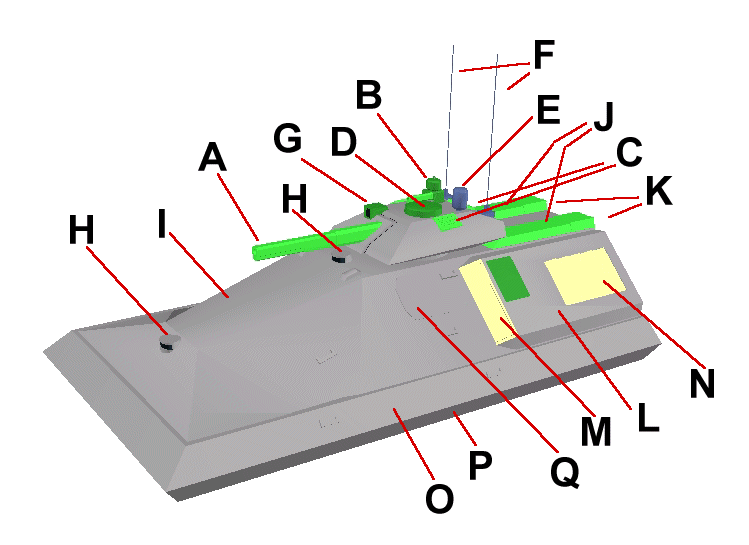
|
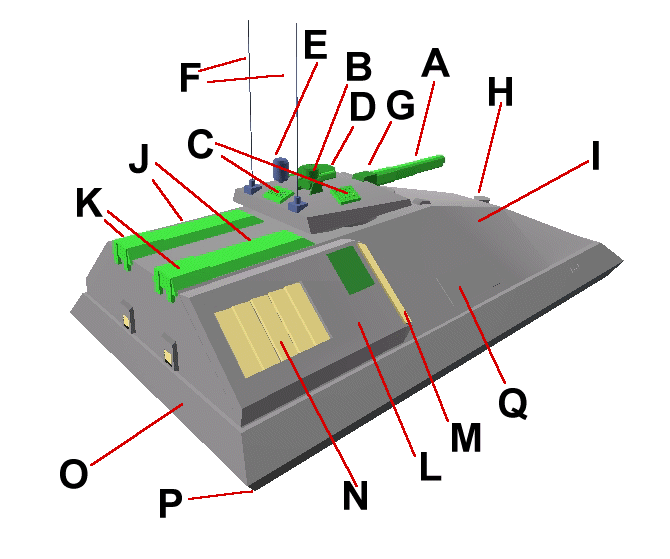
| Weapons
Systems Vickers L86A2 75mm Mass Driver Cannon The Vickers L86A2 MDC is a progressive development of the L70A3 mounted on the Cavalier and late model Cromwell hovertanks. It differs from its predecessors by having enhanced rifling field control enabling the efficient use of HESH ordnance as well as KE rounds. The L86A2 is a robust and efficient weapon system which has benefited from long years of evolutionary development. It is mounted on Montgomery HBT and Churchill ground tanks. The A2 variant has an enhanced fire control system, first fielded in 2295, and fitted in all Montgomery MDC's. This system, built by Black Arrow of Wellon is also now fitted to the current model American MDC. The previous L86 had a +3 fire control computer.
Munitions: The stats given above are for the MARM-2 (Montgomery Armament Standard-2) AP round. The L86A2 is capable of firing a range of munitions. The Montgomery is equipped with 1 40 round magazine, 2 20 round magazines and 2 10 round magazines from which the autoloader can take rounds as required. Most crews carry a mix of rounds, with AP predominating.
BEx Sky Streak Anti-Vehicle Missile The Sky Streak was originally conceived as a low level air defence missile, but was adapted to anti-armour use after French encounters with the Manchurian Type 27 during the Central Asian War. The changes were to the warhead package (to a tungsten penetrator suspended in liquid teflon) and the targeting software. The guidance system has 3 available modes, laser designation {gunner roll}, optical target lock {automatic, following gunner lock on} or self targeting {automatic}. The missiles terminal velocity is in excess of Mach 12, it does however, take a significant time to boost up to it's attack velocity, thus the minimum range of this weapon is 1000m. Attacks below this range are possible, but at a reduced damage {reduce damage by 10% for each 100m below 1000m}. The stats given are for the AV version of this weapon, the SA version has an secondary explosive warhead.
Verlet Defender 7.5mm Vehicular Point Defence Chain Gun The Verlet Defender has been developed from a Royal Dutch Army contract in 2285 to upgrade their LkPz-VIII fleet's point defence system. At the same time the British firm Eldon Systems Ltd was looking to provide upgrades for the popular Dragoon and Hussar family of vehicles in service with many colonial militaries. The result was the Verlet Defender that combines a heavy 7.5mm round with a integral Thermal and Millimetre Wavelength Radar seeker unit. The system provides excellent point defence against conventional ATGW and low-V cannon rounds, but is less effective against Hyper Velocity Missiles and high-V rounds. This unit is also highly effective against infantry. In British service the Verlet Defender has been fitted to Montgomery and late model Cavalier Mk.3's HBT. The Dutch have also adopted this system for their Mechanised Brigades, but there has not been as large a take up amidst other users as was expected, a factor in the commercial demise of Eldon Systems in 2295.
Vickers-Rockwell Model-5 L95A4 Multi-Role 7.5mm Weapons System, Vehicular Role The VR-5 is the current service machine gun of the British Army. Originally a commercial design it was brought into regular service when the L144 proved unsuccessful as a light support weapon. However the VR-5 is a modular design suitable for a variety of roles and with the actively cooled LBSF barrel is capable of sustained fire over prolonged periods. Consequently it was modified with a power-feed unit and replaced the ageing L74A8 MG mounted on previous British tanks which was prone to overheating during long shoots.
|
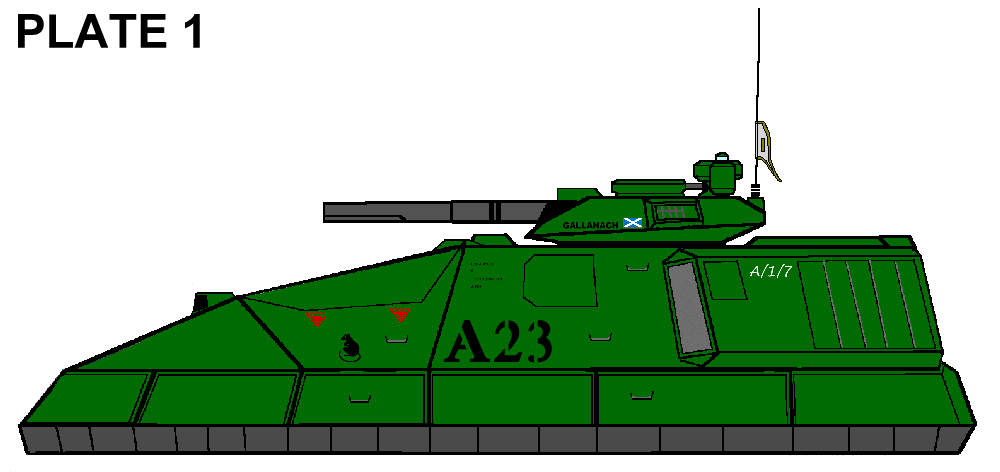
| Montgomery Mk.1, A Squadron, 2nd
Dragoons (Scots Greys), 7th Armoured Brigade Group (Cpl A
Watt) Landing Zone Golf, New Africa, BCV-IV, 28 July 2302 This Montgomery is shown immediately following its landing, and consequently is in a relatively 'clean' state. Most British AFV's operating on BCV-4 would normally acquire a two tone temperate colour scheme soon after arrival and this example would be no exception. Distinctive unit insignia include the squadron pennant (A) flying from the radio antenna and the Cross of St Andrew on the turret. These are both only to be found on Scots Greys Montgomery's. Also prominent on the tank is the 7th Armoured Brigade's historic 'Desert Rat' emblem (B), carried by all vehicles in the brigade. Tactical markings include the large callsign painted amidships (2 Troop's 3rd tank). A newly applied unit code (C) has been chalked onto the intake pod. A/1/7 represents the lead company/squadron of the 1st (most senior in terms of precedence) unit of the 7th Armoured Brigade. This code was a new addition throughout II Corps and would be more permanently applied later in the campaign. An unofficial squadron specific marking is carried on the MDC barrel in the form of 2 black bands denoting the squadron's No. 2 Troop. Command tanks in the Scots Greys carry traditional names but those for troop vehicles are chosen by the crew. This vehicle carries the title 'Gallanach' (D) a small town on the west coast of Scotland. The names of the crew and their blood groups (E) seem to have been recently and rapidly applied just behind the crew compartment. |
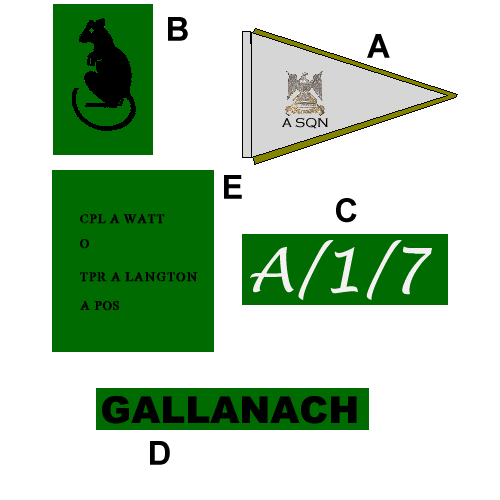
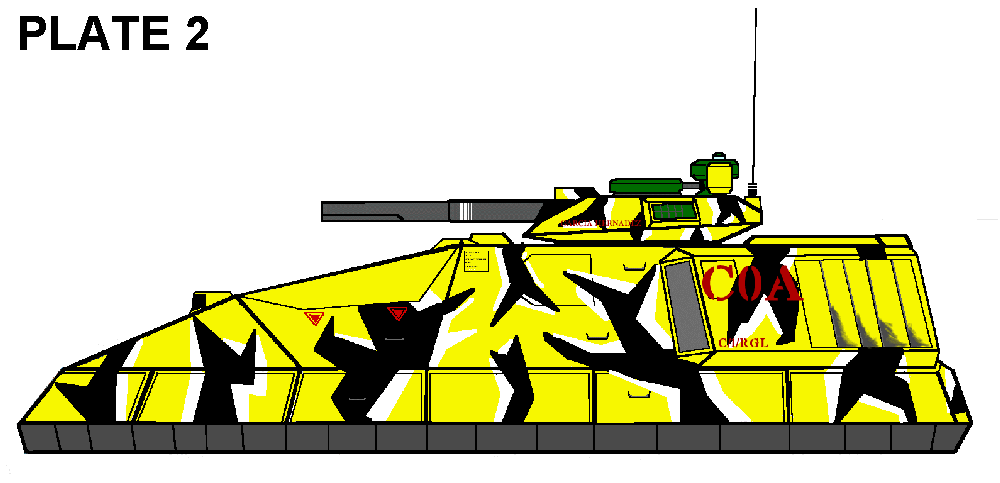
| Montgomery Mk.1, Command Tank, No.3
Squadron, 1st RGL Dragoons, Kampfgruppe
Paterson, 1st Brigade Royal German Legion (Major G
Scheer) Krak des Chevaliers, Crater, Henry's Star, 11th December 2302 This Montgomery is shown at the end of the Dayside Campaign on Crater after the capture of the Kafer fortress of Krak des Chevaliers. The vehicle has been painted locally with a typically garish Dayside high-contrast disruptive pattern found to be most effective in the arid desert. This vehicle seems to have taken some engine damage in the course of the campaign given the smoke build-up on the exhaust louvers. As with most of the RGL vehicles the tank carries no unit specific insignia. Tactical markings include the callsign carried on the intake pod (3 Squadron's main command tank) and the unit code (A) just below it. On the rear of the vehicle above the missile launcher exhaust port the tank carries a military number plate and a small national flag (B), items common to all British Army vehicles. This vehicle carries the title 'Garcia Hernandez' (C), the site of one of this units predecessors greatest victories in Spain in 1812. The other vehicles in the squadron also carry battle honours or the names of Legion heroes. Behind the crew compartment are the crew markings (D), note that this tank carries 3 names as an extra trooper is retained at Squadron HQ to enable the tank to fight if Major Scheer is absent. This spare trooper has added his blood type below his name with white marker. This unit saw substantial combat against the Kafers on both BCV-4 and Crater, and was the only tank unit to be deployed to Crater. Marked on the MDC barrel are two thick and two thin white bands, denoting 12 AFV kills. Major Scheer was a veteran of the War of German Reunification and was noted as a highly skilled and tactically astute armoured soldier even by his crack RGL peers. He was later highly decorated, receiving both a Distinguished Service Order and a Military Cross. |
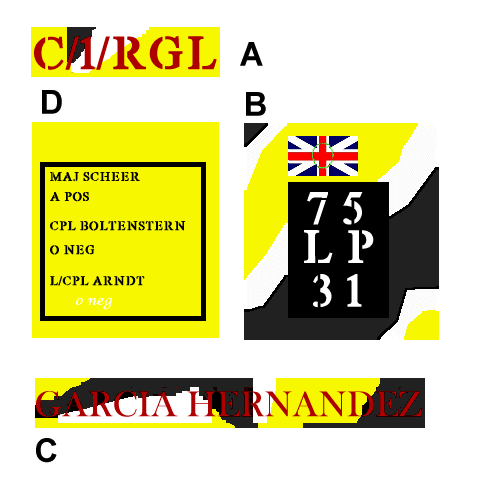
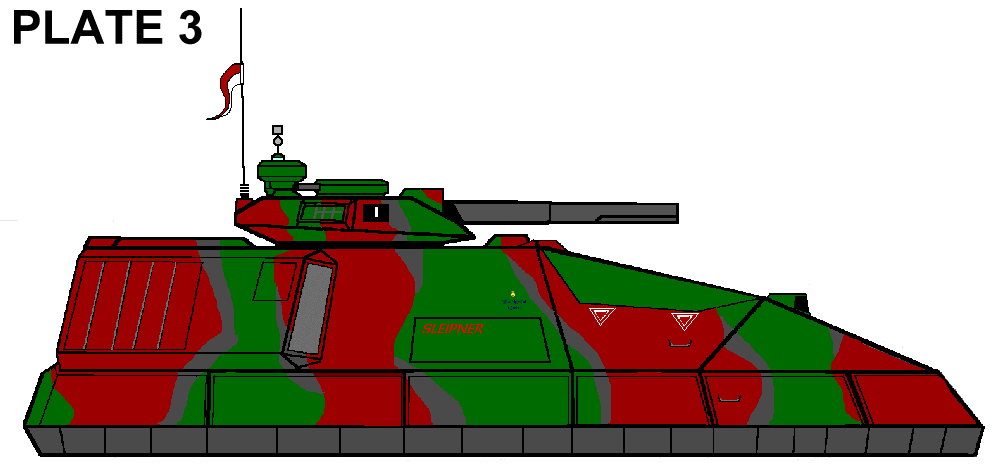
| Montgomery Mk.3, Command Tank, B
Squadron, The Red Lancers of Alicia, 6th Brigade, 1st
Division, Alician Defence Force (Major P K St J
Fitzwilliam ) Heorot, Alicia, Beowulf, 5th January 2303 The detail for this plate is taken from a military display mounted near Heorot. This Montgomery is one of the many equipping the Alician Defence Forces and was made under licence locally (hence the Mk.3 designation). It carries the current 3 colour disruptive pattern used for operations on the mainland. Units slated for operations in the Archipelago use different schemes. Alician vehicles tend to use fewer identifying marks than typical in other British Commonwealth forces, mainly because of security requirements leading from the long stand-off with the neighbouring French colony. However since the start of the Kafer War this has eased somewhat. Senior officers also have more leeway in decorating their vehicles than other, more junior, ranks. This tank carries two distinctive insignia. On the radio antenna flies a traditional lancer pennant (A), whilst on the side of the turret is the 1st Division's simple symbol (B). On the rear of the vehicle is a number plate and Alician flag (C), the number plate uses a format unique to the Alician military. The vehicle's tactical insignia are actually mounted on the top of the point-defence system's mini-turret. This consists of two small shapes (D) that are heated to be visible in the thermal spectrum. This is a common system at battalion level in the Alician Ground Wing, and the meaning of the shapes is frequently changed to maintain security. In this case the round shape signifies B Squadron, whilst the cube represents the HQ Troop. The vehicle carries two personalised insignia. Major Fitzwilliam is a student of classics and mythology and has named his tank 'Sleipner' after Odin's eight legged mount. Behind the crew compartment is a small Alician Rose and the words 'The Lawful Queen' (E). This has become a popular toast amongst certain Alician cavalry regiments as a response to the Northern Grey's toast of 'The Rightful Queen.' |
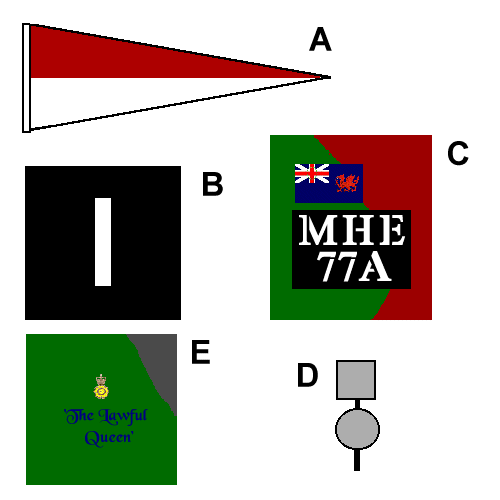
| Notes Designers notes The Monty was designed with 1st edition Fire, Fusion and Steel, with only one modification, a doubling of Duct Fan outputs, to create High Efficiency Ducted Fans. Weapons are mainly FF&S (except the VR-5 which is 3g3 and Corps VDS), with muzzle velocity determining ranges, and damage being equal to FF&S Penetration Rating/2. Round costs were updated to reflect real world data. In the case of the HESH round, it was designed as a variant HE round, with the special effect imported from GURPS:V2e. One of the main assumptions of the system is that the GVGs listed weights are actually displacement weight, like Traveller vehicles, and not actual weights at all. This was borne out be designing GVG vehicles using this system, and getting largely identical stats. To compare, an AC-12 is also in the 60-70 ton weight bracket of the Montgomery. Formulae used to calculate Evasion and Signature were: Evasion: 0.353 * sqrt (Combat Move) Signature: (Displacement Weight * Material Reflection Value) + Power Plant Output (in MW) + 1 point per external weapons mount - stealth modifier. Where stealth modifier is 1 for basic stealth (EM absorbing paint etc.) and 2 for full Electromagnetic Masking (an active stealth system, consuming fairly large chunks of power). For sensors, only use the bonus if a tank has gone active, it is assumed tobe the bonus for using active sensors, and when a more advanced combat system is written up, it will have an effect. The price is higher, but should be compared to real life prices. GVGs vehicles are far too cheap, I'll stick with the higher prices, which are more in line with today's militaries. Point Defence The following PD rules are in use IMC, and can be slipped into any 2k3 game. (All existing 2300 Hovertanks have, IMC, one of their machine guns converted to Point Defence, with a Point Defence Bonus equal to the MDCs Bonus.) First, the actual task of slewing the PDS onto a missile is a task of difficulty depending on the attack mode. The point defence computers modifier, and the players relevant skill are positive modifiers here. Secondly, if the weapon is brought on target in time, a burst is fired to knock down the missile. Deduct the AFV from the missiles homing/ evasion value, and roll d10. If the roll is equal or less than the result, the missile is shot down. A roll of 10 always fails to hit, but a roll of 1 doesn't always succeed.
|